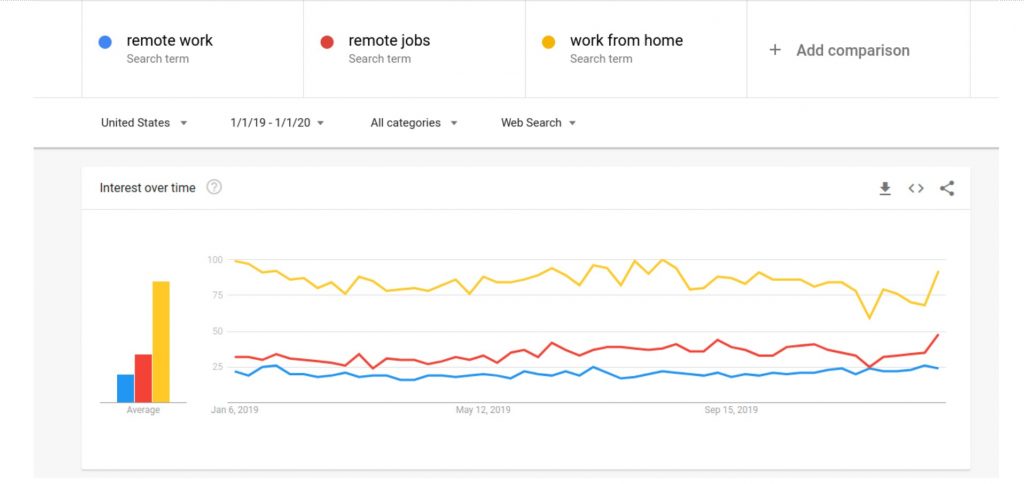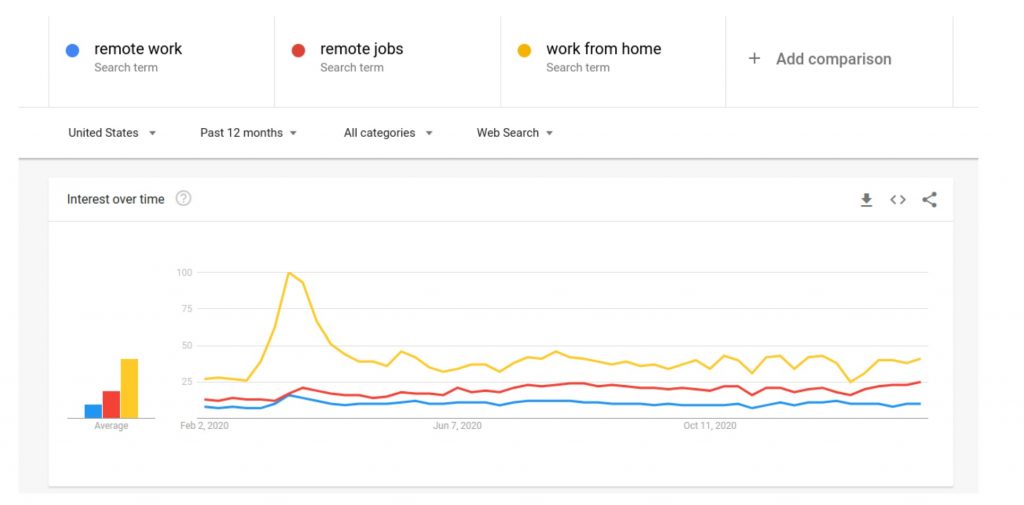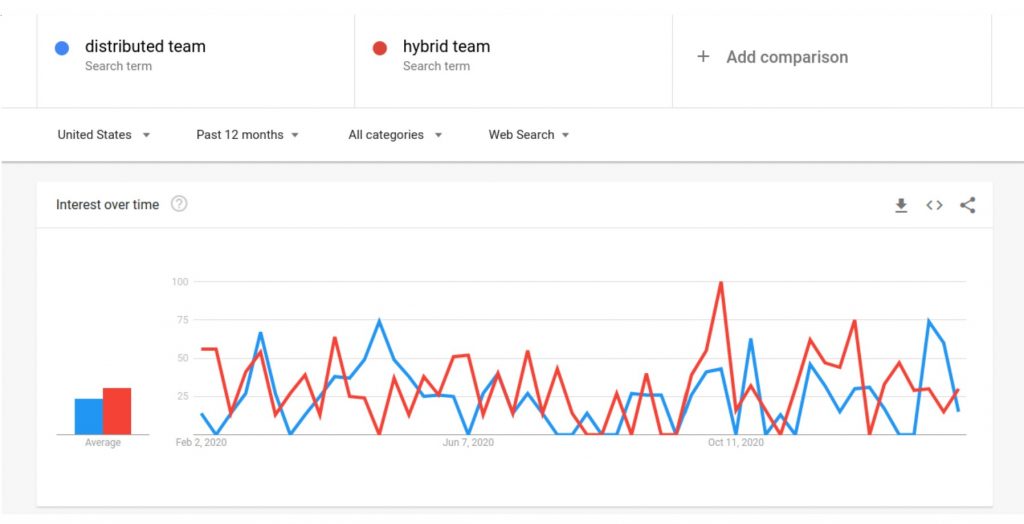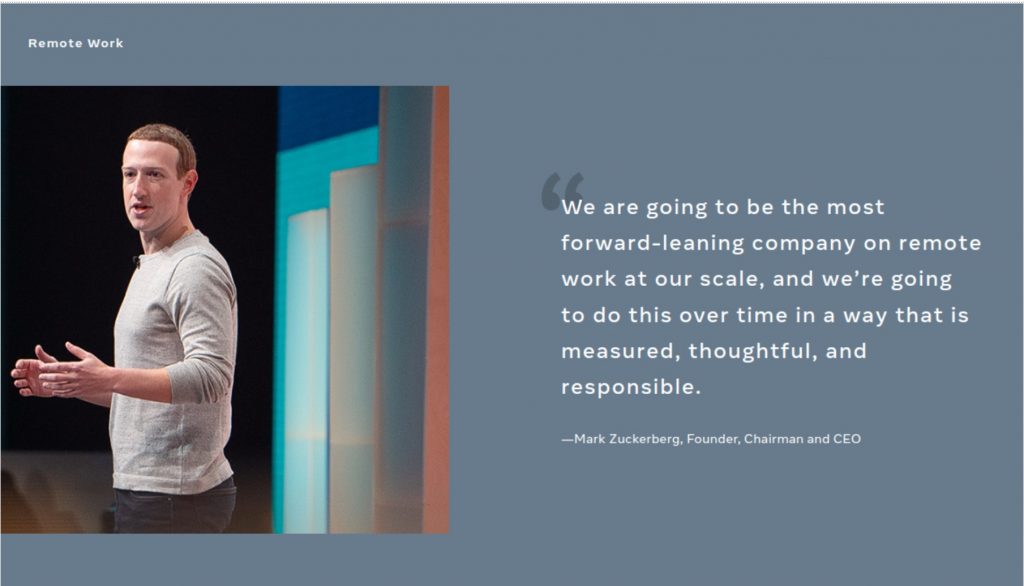It’s real – companies are giving serious thought to distributed teams as the pandemic slowly withers off.
I am sure, the debate has probably started in your office too – Do I get to work from home two days a week? The company down the street is already doing it, why can’t we?
Back then, from co-working spaces to skyscraper offices, buildings got vacated and public transport came to a standstill. Businesses had no option but to shift to remote work.
It was difficult when the lockdowns started but now everyone is returning back to the office with an option at hand.
There are numerous tales of how it went. Some people rejoiced in the comfort of home, some got bored of the drudgery, but everyone adapted.
Now in 2021, as the effects of the virus have begun to shed off, offices are asking – should we really go back to the conference rooms and cubicles?
This question has spurred up the debate at hand – Distributed Teams Vs. In-House – what does the future of work look like?
Table of Contents
What are distributed teams?
When we talk of distributed teams, we’re mainly referring to the geographical distribution of the team members. In a typically distributed team, the members are scattered across several locations which could be their homes, satellite offices or a company headquarter.
Despite being physically distant, these teams are connected via Telecommuting and Team management software, that allow them to work collaboratively.
A distributed team is designed to overcome communication and collaboration challenges that may arise due to team members interacting only on the virtual media.
Distributed teams are synonymous with Remote Teams, Hybrid Teams and Virtual Teams, depending on the context of reference. Essentially, it’s about maintaining productivity and work quality standards, with little to no physical interaction.
Most organizations are working in virtual teams or distributed teams in their own way. Many have permanent remote employees across the globe whereas others have employees swinging by the office whenever needed.
Distributed teams before Covid-19
Distributed teams existed in abundance before the spread of Covid-19. The below graph shows Google Trends reports for “work from home”, “remote jobs” and “remote work” for 2019-20. While these terms were not highly popular, there were still significant searches being made.

The Buffer State of Remote Work 2019 Survey also shows that at least 91% business owners were ready to support remote work in some or the other form at their workplace.

(Source: https://buffer.com/state-of-remote-work/2019
Distributed teams after Covid-19
When the pandemic hit, Google Search traffic observed a growth of over 300% for queries mentioned above. Traffic for “work from home” and “remote work” rose extraordinarily in the United States.

(Source: https://remoters.net/remote-work-trends-future-insights/)

As more people opted for work from home and remote work, the idea of distributed teams also caught fire. Businesses adopted the distributed model, both out of necessity and advantage. The below search interest for “distributed team” and “hybrid team” also confirms the same.

As of 2021, more and more businesses are keen on managing work in a distributed environment.
Micheal Hershfield, VP of product and commercialization at WeWork in his blog post said, “At WeWork, I’ve seen the rise of geographically distributed teams, especially among medium- and large-sized businesses that have between 11 and 999 employees.”
This is true for enterprise players as well. The likes of Amazon, Google, and Facebook have announced several remote working arrangements, much after the pandemic.
Amazon has already announced that the employees will continue to work remotely at least till June 2021 with plans for further extension.
Similarly, Facebook has revised its remote work policies with Zuckerberg’s statement reinforcing remote positions at Facebook.

There’s growing evidence that big tech will be working with distributed teams in times to come.
Pros and cons of distributed teams
Given a chance, will you rather work in a distributed team or an in-house team? An HBR article reports that 96% of US workers would actually settle for the latter. Despite high favorability, only 47% of the workforce actually have access to the desired flexibility.
Let’s understand how distributed teams benefit everyone, and what are the challenges.
The pros of distributed teams
- For the employees
- The remote employees in a distributed team can access remote jobs from anywhere in the world, increasing work opportunities.
- Remote employees save on physical commuting costs which can become a challenge for employees living far-off from the office.
- As employees don’t have to stick to a fixed working schedule or be at a place for a fixed time, they can enjoy the freedom to cater to side-hustles and hobbies.
- Members working in a distributed team environment also report better health conditions as they’re able to put aside time for physical activities alongside work.
- All of the above significantly contribute towards greater levels of personal productivity, as reported by 98% of employees in a Polycom Survey.
- For the employers

(Source: https://buffer.com/state-of-remote-work/2019
- Employers are no more restricted to hiring locally to meet their talent needs, as a distributed team can easily accommodate employees from just about anywhere.
- Having a mix of in-house and remote employees versus only in-house employees, allows employers to cut down on office space expenses.
- In agile distributed teams, employers are able to work with professionals on flexible contracts that help them fulfill requirements that don’t necessarily need a full-time position.
- By offering 50% remote work to employees, companies stand to save up to $11,000 per person in a year.
- 100% remote companies such as Automattic (WordPress parent company) and InVision, are completely free from the hassles that come with managing a brick-and-mortar site.
The challenges in a distributed team
The pandemic saw several innovative solutions to the challenges of working in a distributed team, such as virtual meetings, and remote Team management software. But the challenges still remain. Let’s try to understand them closely.
- For the Employees
- The lack of in-person communication prohibits the employees from gelling up easily and being fully aware of each other’s work attitudes, which leads to conflicts.
- Extensive remote work or on-and-off office work can lead to imbalanced communication, which hampers productivity.
- Employees who don’t have an environment supportive of remote work often find it difficult to be active members of a distributed team.
ProofHub eliminates project gaps for distributed teams with smart asynchronous communication. Try now to see how!
- For the Employers
- Team management aspects such as resource allocation, team communication, and monitoring individual productivity become difficult for the managers.
- If the team has members that are from different time zones, or with varying work schedules, it’s extremely cumbersome to keep everyone collaborating effectively.
- When it’s hard to ensure optimum productivity, the company risks overworking employees, which inadvertently breeds a toxic work environment.
What are In-house teams?
In-house Teams represent the conventional work model where the employees visit the company office on a daily schedule. The team members work in the same office premises and are mostly in close physical reach to each other.
In this article, we are referring to in-house teams based on their physical presence in the office. Many organizations have remote employees that work on the payroll that can also be considered as the “in-house team”.
The most common example of in-house team members are the 9-to-5 workers, who spend their work hours in the office building.
Pros and cons of In-house teams
In-house teams boast several advantages over distributed teams. It’s the work model that has stayed for the longest time but with changing work styles and the recent pandemic, the “in-house” concept has tough competition. Let’s see how.
The Pros of In-house teams
- For the employees
- Employees enjoy a better social connection with fellow mates, as they see them daily, making it natural and easy to empathize with each other.
- Workplaces provide an environment where employees can focus better, as they’re free of distractions, and promote professionalism.
- Team Communication is the easiest to maintain, as the hindrances of virtual platforms are not present.
- For the employers
- Team managers find it much easier to plan resources, share ideas with the team, and cater to overall administration needs.
- As employees are always under the supervision of the employers, they’re generally more satisfied with the accountability of work.
- Centralized office spaces make it possible for the employers to keep the employee engaged, and keep the performance in check.
The challenges of In-house teams
- For the employees
- Maintaining a physical presence in the office in the scheduled hours can become taxing for employees, given commute expenses and cutting down on activities outside work.
- Employees often have to make employment decisions based on the geographical reachability of the office. Offices not in close vicinity often lead to lost opportunities.
- If the workplace has elements of distraction, it can bite back the employees, making them less productive in the in-house team.
As your team goes from 10 to 100, or even 1000, don’t worry about team communication costs with ProofHub. Sign up for free now!
- For the employers
- The cost of running an in-house team at a brick-and-mortar site proves to be much more expensive in comparison to a remote team.
- Employers often make compromises on the availability of talent and have to do the best with what’s available within geographical boundaries.
- As the team and company grow, scalability becomes one of the biggest challenges.
Which team structure should you choose?
We will be trying to make educated future predictions of a world where Covid-19 woes have been eliminated without forgetting the impacts it has made. In the next 5 years, the work trends and office policies will go under major transformations, and you should consider several things before settling for one team structure over the other.
Who will benefit the most from distributed teams?
- Organizations Facing Skill Gaps – Distributed teams offer a definite benefit of acquiring talent that isn’t locally available. Not only it solves skill gaps, but is also a cost advantage. In 2020, IT outsourcing to Tier 2 and Tier 3 countries generated about $92.5 billion.
- Bootstrapped Start-ups and New Businesses – One major advantage of distributed teams is that they’re cheaper to set up, as the businesses can save on operational costs. Startups that need to get the most out of each penny can count on such a team structure, to kick start their business.
- Small Teams Looking to Expand – Expansion is a challenge faced by most teams. The distributed structure makes it possible to expand the team without physically expanding seats in the office. More people can collaborate on projects, without actually raising team management costs.
- Where Employees Face Workplace Challenges – Not all workplaces have been blessed with a fun yet productive environment, some can get grueling for employees. A flexible work environment where coming to the office isn’t a daily obligation can help meet workplace challenges. A Qualtrics survey highlights how 76% of Millenials were ready to take a pay cut in exchange for a flexible work environment.
Is the answer in “best of both worlds”?
- After talking to several experts on the matter and making elaborate observations, it seems that the most beneficial structure is a crossover between in-house and distributed.
- Teams that are strictly choosing to stay in-house-only or going overboard with remote employees, both risk losing out on productivity.
- Quote: The most forward-looking approach to teams is the one wherein certain aspects of the business can be systematically shifted into the remote environment, and employees have a feasible degree of freedom to alter between in-office, and from-home. – Vartika Kashyap, ProofHub
- In 2021, remote work (which is a key element of distributed teams) has been a nuanced experience for everyone. Some favor it, some want to run back to the office. While there are reports of higher productivity in remote jobs, team communication is the best experienced inside the office.
- As the world is split on its stand regarding remote work, it’ll be best to utilize it in moderation. The employees that can fill in remote roles without compromises should be encouraged, whereas, the in-house team should be formed of members who are the best when in the office.
- This “selective distribution” of the team would ensure that it’s feasible to maintain effective communication, and also offer respite from workplace disturbances. Don’t forget to follow the distributed teams best practices covered next in this article.
Expert tips on distributed team management
If you do want to try out the “Distributed Way of Working”, here are some empirical tips that will save you from regrets later.
Develop a distribution structure
- The first step is to identify who all can afford to work remotely.
- We call this “Flex Work Policy”. It basically recognizes the business requirements of the process, the suitability of remote work for the process, and compensation schemes, before offering remote work to an employee.
- While hiring, this policy helps us enlist “Remote Only”, “Remote Optionally” and “Remote Part-Time” positions.
- In case an employee wants to work from home, the provision is open, and approval is handed as per the policy.
- This way, we are able to counterbalance team productivity, with the benefits of remote work. In the end, you’ll have a clearly defined structure of in-house plus remote employees, and at what times they’re rostered to work.
Be mindful of employees you’ll not meet often
- Dr. Cristina Gibson is a management expert from Pepperdine Graziadio Business School, California, with extensive experience in virtual team management.
- She advises against taking the same communication approach to all employees, regardless of where they’re working from.
- According to Dr. Gibson, employees who are out of sight, need to be communicated at a personal level, in order to get a better picture of their professional setup and work habits.
- Failing to do so will cultivate gaps in understanding, and an overall loose sense of touch with the person, which makes effective management very difficult.
- Therefore, it’s advisable that a proactive communication approach is used, for which tools like Troop Messenger, or Skype can be used.
Bind everyone together using a team management tool
- The greatest downside, and the biggest challenge to distributed teams is fragmented communication.
- Opposed to an in-house environment where it’s obvious to be in the loop of project updates, and sharing bits of information is easy, remote teams need a software tool that could glue the fragments together.
- Some offices require a full-blown team management tool such as ProofHub to manage the flow of information on their projects. Whereas some would easily manage with a simple chat application such as Skype.
- It’s onto you to figure out the exact requirements and introduce the right tool accordingly.
See how you can make remote employee communication as fluid as desk-side chatter, with ProofHub. Sign up to experience now!
The power of culture
Organizations thrive on good culture. It’s rather easy for employees to feel detached from the company’s culture in a distributed environment because the culture is built by little but continuous gestures throughout.
In the office, these gestures are quick to catch and imbibe in one’s perspective. But as the team grows virtual and the team members lose the human touch, these gestures need to be proactively reintroduced.
Joe Hopkins, an expert in Leadership and Organizational Development, points out the need for one-on-one conversations for introverted team members. He also suggests that it will need more than virtual team building games, and monthly offline meets to shape the culture in a fragmented environment.
Also Read: Hybrid Team Management: Best Advice From The Experts
ProofHub for distributed teams
ProofHub is designed to keep team communication streamlined no matter where the team members are.
Following are a few of the ProofHub benefits that would make life easier for distributed teams.
Everyone stays in the loop, no matter where
ProofHub lets you create accounts for everyone in your team so that you can tag them in comments and tasks.
This reduces task management hurdles for the managers. Whenever a new task is assigned, completed, or shelved, the entire team instantly comes to know. If there’s client feedback or additional comments, those can also be added alongside each task.
Each project update sends out an email, or a ping on the mobile app, providing a minute-to-minute log of what’s happening in the project.
Therefore, it doesn’t matter if the team members are visiting the office or working remotely, they’ll stay in the loop.
ProofHub is easy to use outside the office
ProofHub provides IP whitelisting and a personalized secure domain for your team. You can safely access it from inside or outside the office without breaching security protocols.
ProofHub is available on Desktop, Laptop, and Mobile so that you can switch devices with convenience.
For distributed teams, this means that remote members can safely manage all project communication on their devices without worrying about VPNs, unauthorized access, or security tokens.
You can track and report productivity objectively
One significant challenge in managing distributed teams is that productivity is hard to track.
ProofHub solves with the help of productivity reporting tools. Managers can get a clear estimate on how much time each task is taking, while also getting an idea of the overall team productivity.
The Gantt Chart view enables managers to get a bird’s eye view of project timelines, so that nothing skips their priority list, and project estimates are up to the mark.
ProofHub prevents employees from Overworking
Remote jobs claim that sometimes employees end up overworking due to miscommunication, or lack of clarity on tasks. Typical virtual medium problems.
ProofHub prevents this by providing defined workflows, and an elaborate “My Tasks” section which clearly reports,
- What is to be done
- Comments for instructions
- Assigned timeline for the tasks
- Provision to ask questions
- Workflow for managing dependencies
Conclusion
There are several benefits of shifting to a distributed team but it’s still very new for most organizations and an unplanned maneuver can cause more problems than it solves.
Hence, I suggest organizations to be extremely mindful of their approach towards distributed teams and carry out the transitions (if they will), in a highly phased manner.
If you change your approach from a fixed in-house working schedule to this distributed flexible scheduling scenario, keep three things in mind;
- Quality work always triumphs over quick work
- Remote work brings emotional detachment
- A distributed team means more planning, but less stress
I also suggest going for an overlap between in-house and distributed teams, which ensures minimum resource wastage, and offers easier adaptability.
As offices realize the benefits of distributed team structures and begin to adopt the same in their workplace, we’ll see more innovation carried out in this domain.
I believe the software tools will have a major role to play in this hybrid way of working, where employees are constantly switching between remote and office work.
